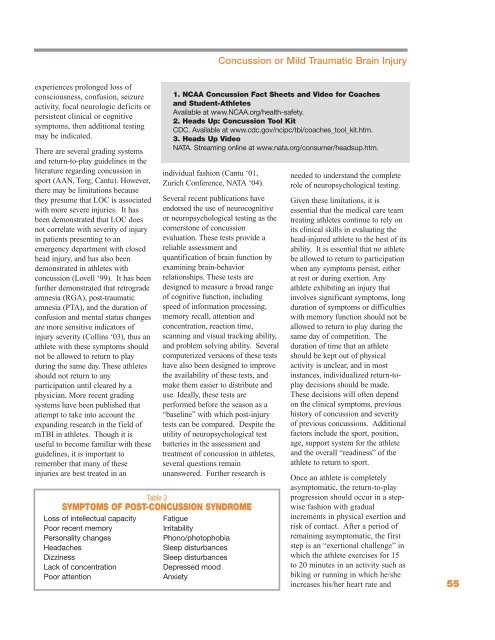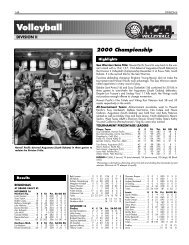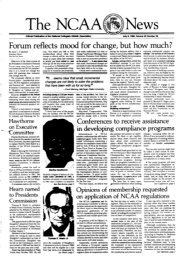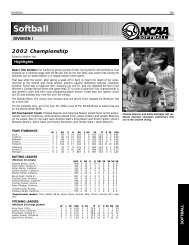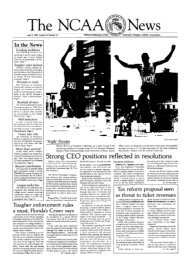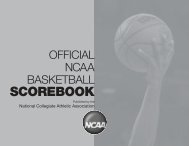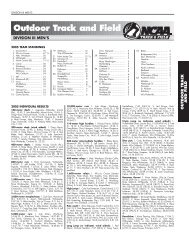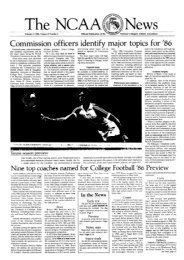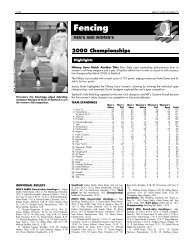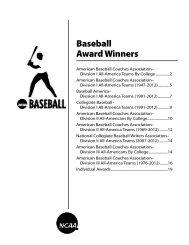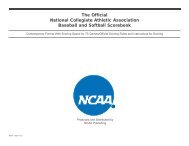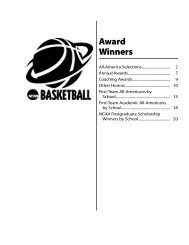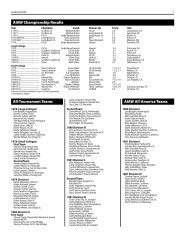Sports Medicine Handbook - NCAA
Sports Medicine Handbook - NCAA
Sports Medicine Handbook - NCAA
You also want an ePaper? Increase the reach of your titles
YUMPU automatically turns print PDFs into web optimized ePapers that Google loves.
experiences prolonged loss of<br />
consciousness, confusion, seizure<br />
activity, focal neurologic deficits or<br />
persistent clinical or cognitive<br />
symptoms, then additional testing<br />
may be indicated.<br />
There are several grading systems<br />
and return-to-play guidelines in the<br />
literature regarding concussion in<br />
sport (AAN, Torg, Cantu). However,<br />
there may be limitations because<br />
they presume that LOC is associated<br />
with more severe injuries. It has<br />
been demonstrated that LOC does<br />
not correlate with severity of injury<br />
in patients presenting to an<br />
emergency department with closed<br />
head injury, and has also been<br />
demonstrated in athletes with<br />
concussion (Lovell ‘99). It has been<br />
further demonstrated that retrograde<br />
amnesia (RGA), post-traumatic<br />
amnesia (PTA), and the duration of<br />
confusion and mental status changes<br />
are more sensitive indicators of<br />
injury severity (Collins ‘03), thus an<br />
athlete with these symptoms should<br />
not be allowed to return to play<br />
during the same day. These athletes<br />
should not return to any<br />
participation until cleared by a<br />
physician. More recent grading<br />
systems have been published that<br />
attempt to take into account the<br />
expanding research in the field of<br />
mTBI in athletes. Though it is<br />
useful to become familiar with these<br />
guidelines, it is important to<br />
remember that many of these<br />
injuries are best treated in an<br />
individual fashion (Cantu ‘01,<br />
Zurich Conference, NATA ‘04).<br />
Several recent publications have<br />
endorsed the use of neurocognitive<br />
or neuropsychological testing as the<br />
cornerstone of concussion<br />
evaluation. These tests provide a<br />
reliable assessment and<br />
quantification of brain function by<br />
examining brain-behavior<br />
relationships. These tests are<br />
designed to measure a broad range<br />
of cognitive function, including<br />
speed of information processing,<br />
memory recall, attention and<br />
concentration, reaction time,<br />
scanning and visual tracking ability,<br />
and problem solving ability. Several<br />
computerized versions of these tests<br />
have also been designed to improve<br />
the availability of these tests, and<br />
make them easier to distribute and<br />
use. Ideally, these tests are<br />
performed before the season as a<br />
“baseline” with which post-injury<br />
tests can be compared. Despite the<br />
utility of neuropsychological test<br />
batteries in the assessment and<br />
treatment of concussion in athletes,<br />
several questions remain<br />
unanswered. Further research is<br />
Table 2<br />
SYMPTOMS OF POST-CONCUSSION SYNDROME<br />
Loss of intellectual capacity<br />
Poor recent memory<br />
Personality changes<br />
Headaches<br />
Dizziness<br />
Lack of concentration<br />
Poor attention<br />
Fatigue<br />
Irritability<br />
Phono/photophobia<br />
Sleep disturbances<br />
Sleep disturbances<br />
Depressed mood<br />
Anxiety<br />
Concussion or Mild Traumatic Brain Injury<br />
1. <strong>NCAA</strong> Concussion Fact Sheets and Video for Coaches<br />
and Student-Athletes<br />
Available at www.<strong>NCAA</strong>.org/health-safety.<br />
2. Heads Up: Concussion Tool Kit<br />
CDC. Available at www.cdc.gov/ncipc/tbi/coaches_tool_kit.htm.<br />
3. Heads Up Video<br />
NATA. Streaming online at www.nata.org/consumer/headsup.htm.<br />
needed to understand the complete<br />
role of neuropsychological testing.<br />
Given these limitations, it is<br />
essential that the medical care team<br />
treating athletes continue to rely on<br />
its clinical skills in evaluating the<br />
head-injured athlete to the best of its<br />
ability. It is essential that no athlete<br />
be allowed to return to participation<br />
when any symptoms persist, either<br />
at rest or during exertion. Any<br />
athlete exhibiting an injury that<br />
involves significant symptoms, long<br />
duration of symptoms or difficulties<br />
with memory function should not be<br />
allowed to return to play during the<br />
same day of competition. The<br />
duration of time that an athlete<br />
should be kept out of physical<br />
activity is unclear, and in most<br />
instances, individualized return-toplay<br />
decisions should be made.<br />
These decisions will often depend<br />
on the clinical symptoms, previous<br />
history of concussion and severity<br />
of previous concussions. Additional<br />
factors include the sport, position,<br />
age, support system for the athlete<br />
and the overall “readiness” of the<br />
athlete to return to sport.<br />
Once an athlete is completely<br />
asymptomatic, the return-to-play<br />
progression should occur in a stepwise<br />
fashion with gradual<br />
increments in physical exertion and<br />
risk of contact. After a period of<br />
remaining asymptomatic, the first<br />
step is an “exertional challenge” in<br />
which the athlete exercises for 15<br />
to 20 minutes in an activity such as<br />
biking or running in which he/she<br />
increases his/her heart rate and<br />
55


